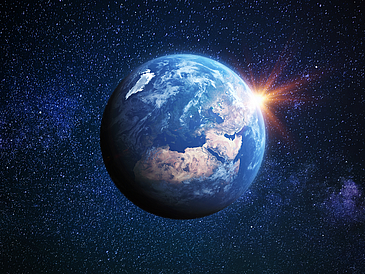Time is the same everywhere? A common everyday mistake. Anyone who has paid attention to physics knows: time is relative. With a very fast moving object, time passes more slowly. An astronaut therefore ages more slowly, even if this is hardly measurable. This is what the special theory of relativity says. But there is also the realization of the general theory of relativity, which states that time passes more slowly in the vicinity of large masses. Since the mass attraction (gravity) decreases as you get higher above the Earth’s surface, time passes faster at high altitudes. With today’s most precise atomic clocks, we can observe at heights of just one centimeter that time passes by faster than further down.
These relationships also play a major role in surveying the Earth. Knowing the planet as accurately as possible is of key importance, especially with regard to climate change and natural disasters. The exact description of the Earth’s surface is crucial, for example, when it comes to sea level rise due to the melting of the polar caps – one of the most inaccurate variables at present. The main objective of the new research group mentioned at the beginning is to introduce “time coherence” as an additional connecting factor for geodetic measurement techniques – as well as integrating optical clocks in order to be able to measure the Earth even more precisely in the millimeter range.
The new DFG group is coordinated by the Technical University of Munich, but experts from the University of Bremen are also involved. With Professor Justus Notholt and Dr. Matthias Palm, the Institute of Environmental Physics (IUP) is dedicated to the modeling of atmospheric influences on signal transmission. The group led by PD Dr. Eva Hackmann and Professor Claus Lämmerzahl at the Center of Applied Space Technology and Microgravity (ZARM) is responsible for the general relativistic description of signal transmission and clock rate. In total, the two university facilities will receive more than 600,000 euros for four years. This allows each institute to finance a doctoral position to qualify junior researchers.
Geodesy: The Science of Measuring and Mapping the Earth
What is geodesy? It is the science of measuring and mapping the Earth’s surface. This refers to the determination of the geometric shape of the Earth, its gravitational field, and the orientation of the Earth in space. A decisive factor is time – the most fundamental factor in physics. “All the operations and processes of our everyday lives take place in time. And time is everywhere, no matter where you are. But what does time in one place have to do with time in another? What sounds like a trivial question is highly complicated with the precise atomic clocks we have today,” explains Claus Lämmerzahl. “To transmit time information from one place to another, you have to take into account the height of the places, for example. And it will be particularly critical if rotations – such as those of the Earth – also come into play. At first, it is no longer possible to transmit time consistently using the usual methods.”
But how this can be done now – on a large scale – is being discussed in the newly approved research group. There, scientists are investigating how to synchronize different clocks on Earth using pulsars (fast and very stable rotating neutron stars), using satellites with and without clocks on board, and with a planned high-precision atomic clock on the ISS. “The research group covers the entire spectrum of this question, from the provision of clocks in the laboratory to the modelling of weather-related influences on the signal path to the ISS to the general relativistic principles and effects,” says Justus Notholt.
The expected results are of great importance to society and were also set out in the UN resolution on Global Geodetic Reference Frame for Sustainable Development (GGRF) adopted by the United Nations on February 26, 2015. “Global reference systems are the metrological basis for a variety of applications,” says Notholt. “The highest precision and long-term stability of the reference system are of paramount importance for assessing long-term trends, such as sea level changes.”
Contact:
Professor Claus Lämmerzahl
Center of Applied Space Technology and Microgravity (ZARM)
University of Bremen
Tel. +49 421 218-57834
E-mail: claus.laemmerzahlprotect me ?!zarm.uni-bremenprotect me ?!.de
Professor Justus Notholt
Institute of Environmental Physics
University of Bremen
Tel.: +49 421 218-62190
Email: notholtprotect me ?!uni-bremenprotect me ?!.de

